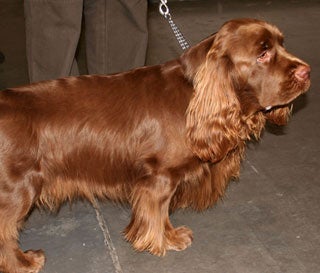Learn about dog breeds
Detailed information & photos on over 190 different breeds
Description
Considered by many as the stockiest of the spaniel breed, the Sussex Spaniel is a medium-sized dog with a rather long but muscular body. Ideally, this dog should be around 16 inches at the shoulder when fully grown. The Sussex Spaniel’s front legs are somewhat shorter than its hind legs to accommodate its barrel chest. Its paws are wide with feathery hair in between the toes. This dog’s tail never extends above its body; it usually stays parallel to the ground and moves furiously from side to side when the dog is excited. If the Sussex Spaniel’s tail goes undocked, it can grow as long as a quarter of its body length, tail feathers included.
The Sussex Spaniel’s head is broad with a pronounced brow ridge, giving it a perpetually sad and thoughtful expression. Its handsome face is usually topped with widely spaced eyes that are usually deep hazel in color. This dog has a short muzzle, and a light colored nose. Its long, triangular-shaped, feathery ears usually extend droopily over its shoulders.
Coat Description
The standard color of the Sussex Spaniel’s coat is a shiny golden red (or liver colored) with lighter colored feathery tips. The fur on its ears, chest and legs tend to be wavy. Its tail, hind legs and underbelly hair are usually straight and more bristle-like. However, the dog also carries a thicker layer of undercoat that helps it retain body heat during the colder seasons.
The standard Sussex Spaniel should have a golden liver color with lighter tip hues. Any derivation of color is often considered undesirable for this breed.
History
Sussex, England is the place where the first line of this spaniel breed came into existence. In 1795, a Mr. Fuller from Rosehill developed and maintained a dog kennel of special-purpose gun dogs that could weather rough terrain and dense undergrowth. The spaniel had always been a favorite breed in England but during that time, there wasn’t any one breed of spaniel that could do the above tasks and alert the hunter to its quarry at the same time.
Although its record line is sketchy at best, it is said that the Sussex Spaniel probably came from a mix of Field Spaniel, Liver Norfolk, White Norfolk and Springer Spaniel. While the Sussex Spaniel maintained its popularity from the 1800 and afterwards, it was subsequently entered into the American Kennel Club stud book in 1884. The breed was almost obliterated during World War II, when its breeding was actively discouraged by dog enthusiasts. By 1947, only 10 dogs from this line were registered in the English Kennel Club. However, an American breeder managed to save the breeding line, and now, the Sussex Spaniel has become a very common breed in the United States.
Temperament
The Sussex Spaniel is incredibly friendly, and it is known for its sweet disposition. It is very much dependent on human companionship. This dog is especially gregarious with its human handlers and companions, so much so that it will develop deep, clingy loyalty to them. As a household pet, the Sussex Spaniel is gentle enough to be in the presence of toddlers and very young infants.
The Sussex Spaniel is a bundle of raw energy and high-nerves during hunting and play, so this dog may not be suitable for those who are seeking a quiet pet that will lounge contentedly in the apartment for long hours. It needs a great deal of exercise and enough space to be happy.
Health Problems
Regular and thorough grooming is essential to maintain the Sussex Spaniel’s health. It is susceptible to all manners of ear infections and may need regular trips to the vet for ear inspection and cleaning. This dog is also susceptible to ocular diseases like cataract, entropion and retinal dysplasia. The Sussex Spaniel can also gain weight exceedingly fast, making it susceptible to cardiomyopathy.
Grooming
Like all long-haired dog breeds, the Sussex Spaniel needs regular grooming. Otherwise, its long fur can become matted and cause discomfort and illnesses. A regular regiment of fur brushing (at least twice a week) should keep the dog’s fur luxurious and tangle free. Try to schedule for regular trips to the vet for ear and eye medical inspections. Regular fur trimming is also essential as well as nail clipping and dental examination. Baths should be given infrequently so that the sheen of the dog’s coat can be maintained.
Exercise
As a rule, spaniels are very active animals, and the Sussex Spaniel is no exception. A regular daily exercise regiment (a two mile walk) will help maintain its ideal body weight. However, it will help greatly if you will let the dog romp at least once a week so that it can expend its pent-up energy.
Training
The Sussex Spaniel is a hunting dog, and when properly trained, it is capable of following the instructions of its human companions explicitly. It is also known to posses problem-solving abilities and can handle basic training quite easily. According to many dog enthusiasts, the Sussex Spaniel is very easy to teach. However, it can be playfully stubborn and it will not respond well to negative reinforcements.
Advertise | Privacy Policy | Terms of Use | Contact Us © Copyright 2004-2024 PupCity.com. All rights reserved.
